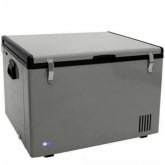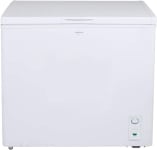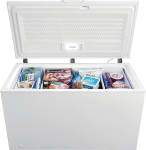The Rundown
- Our favorite chest freezers are the Koolatron KTCF195 and the Whynter FM-85G.
- When choosing a chest freezer, consider storage capacity, temperature control, energy efficiency, and durability to match your specific needs.
- Look for features like child safety locks, temperature alarms, and robust gaskets for optimal performance and safety.
We’ve all been there—you’ve come back from a huge grocery run, but you can’t fit all your frozen products into your fridge’s tiny freezer. Sure, you can always Tetris your broccoli and popsicles to maximize that space, but it can be a huge hassle, especially during your busy week.
That’s why many people turn to chest freezers to stock up and maintain cold goods throughout the year. With the right chest freezer, you can bulk-buy at shops like Costco without having to worry about stuffing it all into a tiny space—within reason, of course. These appliances vary widely in size and functionality, so we picked seven different options that suit different use cases. Regardless of your living space or needs, we’ve got a chest freezer that’s right for you.
What to Consider When Buying a Chest Freeze
Knowing how you want to use your chest freezer and where it will be located are critical when picking out the right model for you, of course, but what else should you keep in mind? These are the most important features to consider.
Storage Capacity
No matter what your storage needs, there’s a chest freezer the right size for you. If you’re looking for something compact, models as small as 7 cubic feet can tuck away in small spaces to provide overflow storage for frozen goods. If you’re a prolific hunter, meal prepper, or bargain shopper, you may want something larger — maybe even as large as 15 cubic feet or more. For average storage needs, Maytag recommends 2.5 cubic feet of space per family member — in any case, each square foot of freezer space can accommodate approximately 25 pounds of frozen food. Take into account how much food you intend to store, and how big it is (frozen pizzas have very different space needs than a half cow, for example.
Temperature Control Settings
For long-term food storage and avoiding freezer burn, your chest freezer should maintain an internal temperature between -10 and -20 degrees Fahrenheit. Digital temperature controls are more consistent than analog dials.
Energy Efficiency
Look for Energy Star-rated chest freezers, which will show how much energy each model is expected to use over the year. The less energy the chest freezer uses, the more efficient it is – and the more money you’ll save.
Durability
For the most efficient and long-lasting chest freezer, look for substantial rubber gaskets on the lid, ideally ones that can be easily replaced. Aluminum interiors hold cold temperatures better than plastic ones, and resist scratches better, too. Heavy-duty hinges (counterbalanced hinges especially) are smart choices as well. Finally, powder-coated steel and commercial-grade stainless steel finishes on the exterior will hold up to dents and scratches, no matter where you store it.
Safety Features
If you have kids in your home, look for features that can keep them safe and out of the freezer, especially a child safety lock in the handle. Some models also include temperature alarms that will sound if the internal temperature of the freezer drops below a certain threshold during a power outage or if the door is left ajar. Knowing when your food has been above safe temperatures can prevent spoilage.
More Articles About Refrigerators on Reviewed











